How to use an Instant Pot: A Beginner’s Guide to Pressure Cooking
If you’ve been wondering how to use an Instant Pot, this beginner’s guide to pressure cooking is for you. Here I dive into what this ultra-popular gadget is, how it works, and what to cook in it. At the end, I will also provide you with some of my favorite Instant Pot recipes for beginners to help you get started.
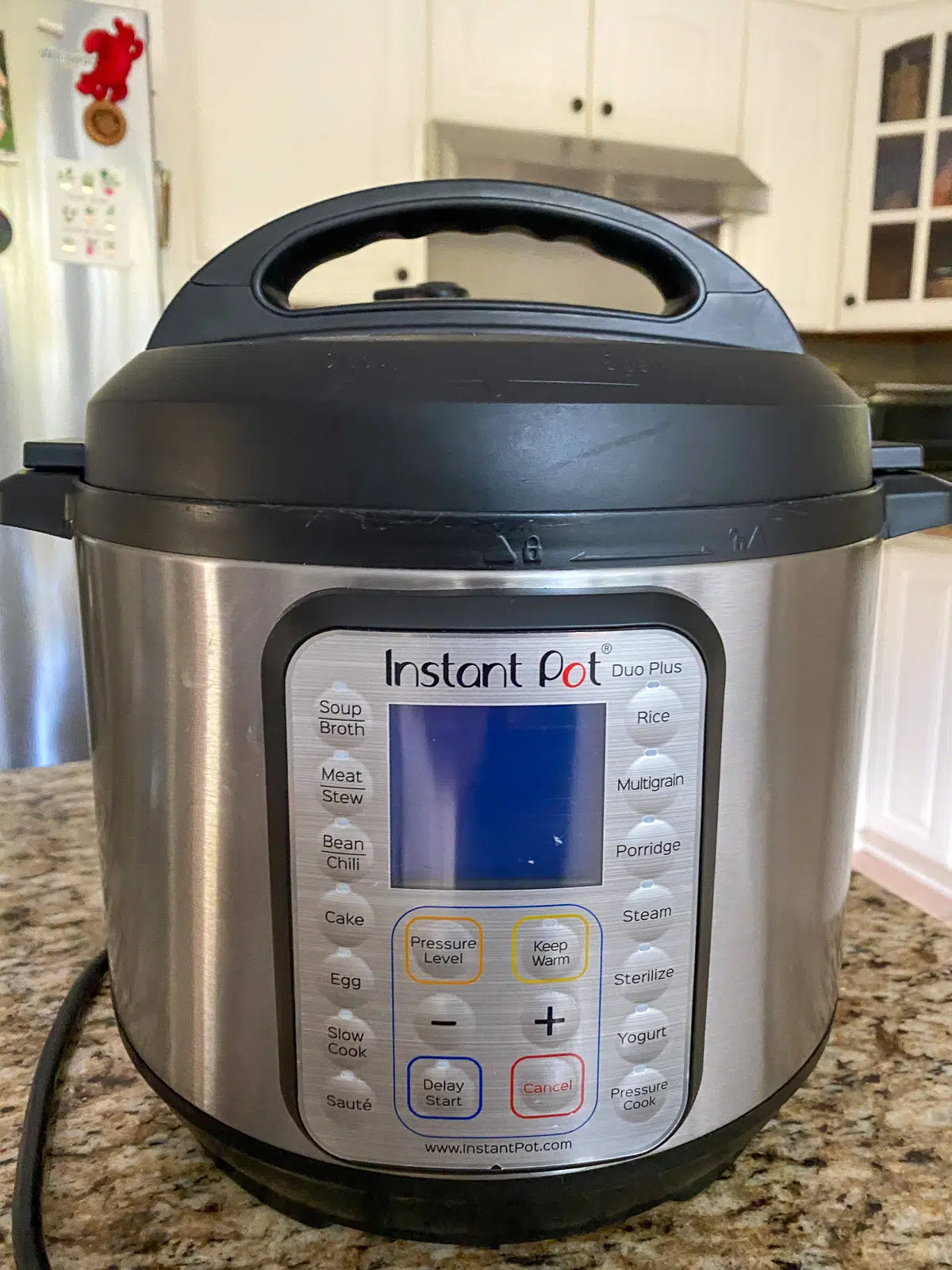
What you are seeing above is my much loved and often used Instant Pot. I didn’t want to alter it in any way so you could see what one looks like after three years of weekly use.
When I started using my Instant Pot, it revolutionized the way I prepared my food. I mean, you can do just about anything with this bad boy. With the click of a button, you can make everything from soup to shredded chicken and even homemade yogurt. It’s the classy and much more tech-savvy older sibling of your classic pressure cooker.
By the time you’ve finished reading about how to use an Instant Pot, you will have all the tools you need to make any dish your heart desires. Whether you’re new to the wild world of pressure cooking or are looking for new tricks to try out, this guide is for you. Get ready for the Instant Pot to become your new best friend. Now, let’s get into it!
What Is an Instant Pot?
Before you can become an Instant Pot pro, you should probably understand what an Instant Pot is. Think of your average pressure cooker. Now, imagine that pressure cooker with superpowers.
An Instant Pot is an electric pressure cooker with the ability to sauté, steam, slow cook, sterilize, warm, and cook an insane variety of foods. It can boil eggs, cook beef stew, make yogurt, prepare rice, cook beans, and so much more.
With minimal effort, you can cook anything you would normally cook in the oven, on the stove, or in a crock pot. It’s essentially an all-in-one device designed to make your life and your cooking a whole lot easier. All you have to do is add your ingredients, select the right setting, then sit back and relax. Sounds great, right?
Instant Pot Components
Wondering how an Instant Pot works? There are several components that make up the device. Let’s break each one down, nice and simple.
Inner Pot: Pictured below is the removable cooking pot that fits into the base unit. It’s made from stainless steel and can be used either in the base unit or on the stove on its own.
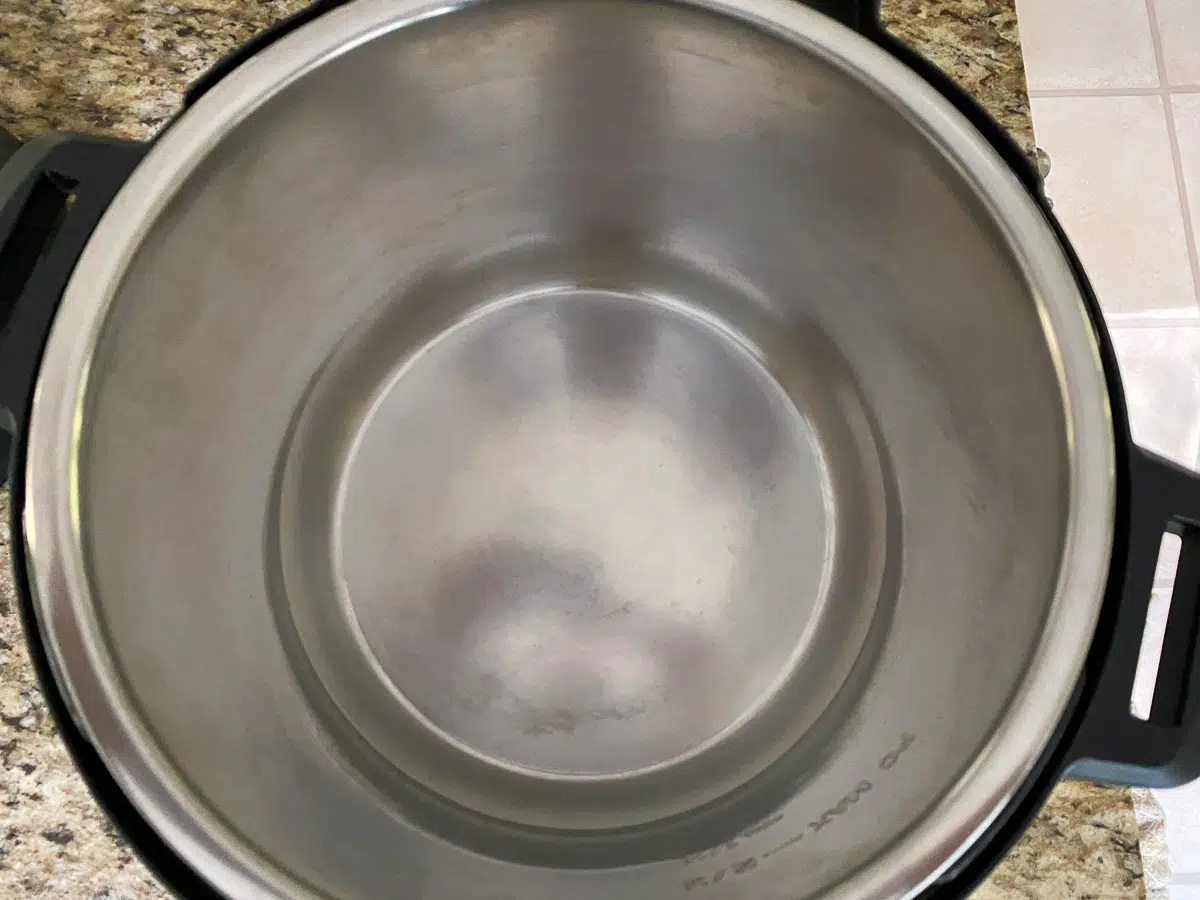
Base Unit: The bulkiest part of the Instant Pot, this is the component with a built-in heating element. It also has a control panel of adjustable settings on the outside for cooking all sorts of foods.
You can change the pressure from “high” to “low” just by pressing the “pressure level” button; it will cycle between the two levels. (A)
All the buttons on the control panel have preset cook times. You can change the cook time on any of the buttons by pressing either the minus or plus button. (B)
I have done all my cooking on “normal” mode; I’ve never changed it off of that mode. The only reason to change it from normal to “less” or “more” is because you want to cook something less or more time. For example: if you want al dente white rice, you will switch the mode to less. Or if you have a tough grain or mixture of rice, you would switch it to the “more” mode.
To do that, press the button “rice,” for example, more than once to get to the mode you want.
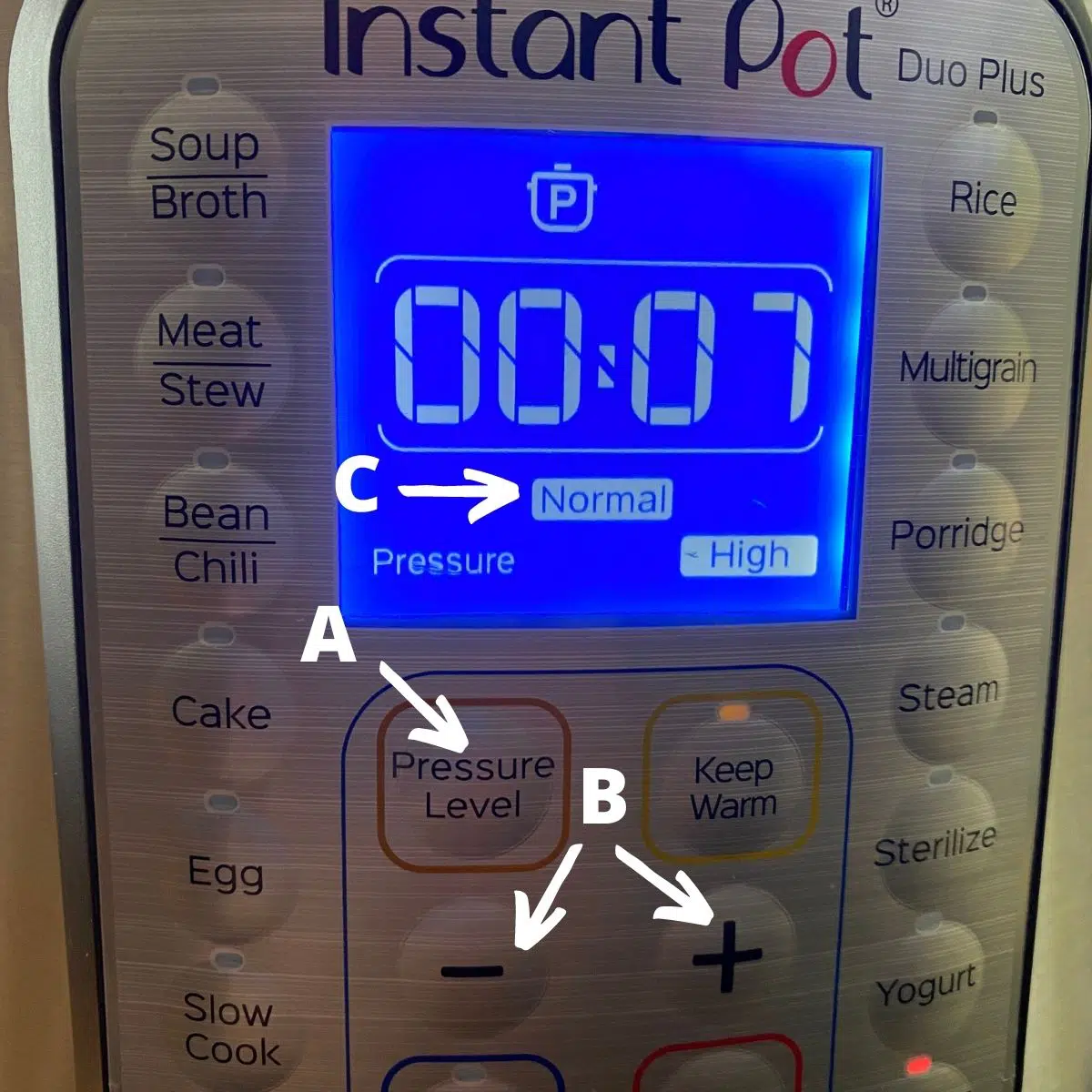
A cool feature
Pictured below, on the left, you see the handle slot in the body of the IP, and on the right you can see the lid of the cooker balanced in that slot. I do this when I’m adding something extra to the pot for the last stage of cooking.
For instance, with my whole chicken soup recipe, after the soup has cooked a certain amount of time, I open the IP, remove the finished chicken to de-bone the meat, add orzo or some other pasta, replace the lid to cook for another 6 minutes, and add back the chicken meat when the soup is done.
I will also set the lid in the handle slot to allow the condensation drain that collects on the lid to be funneled into a condensation collector.
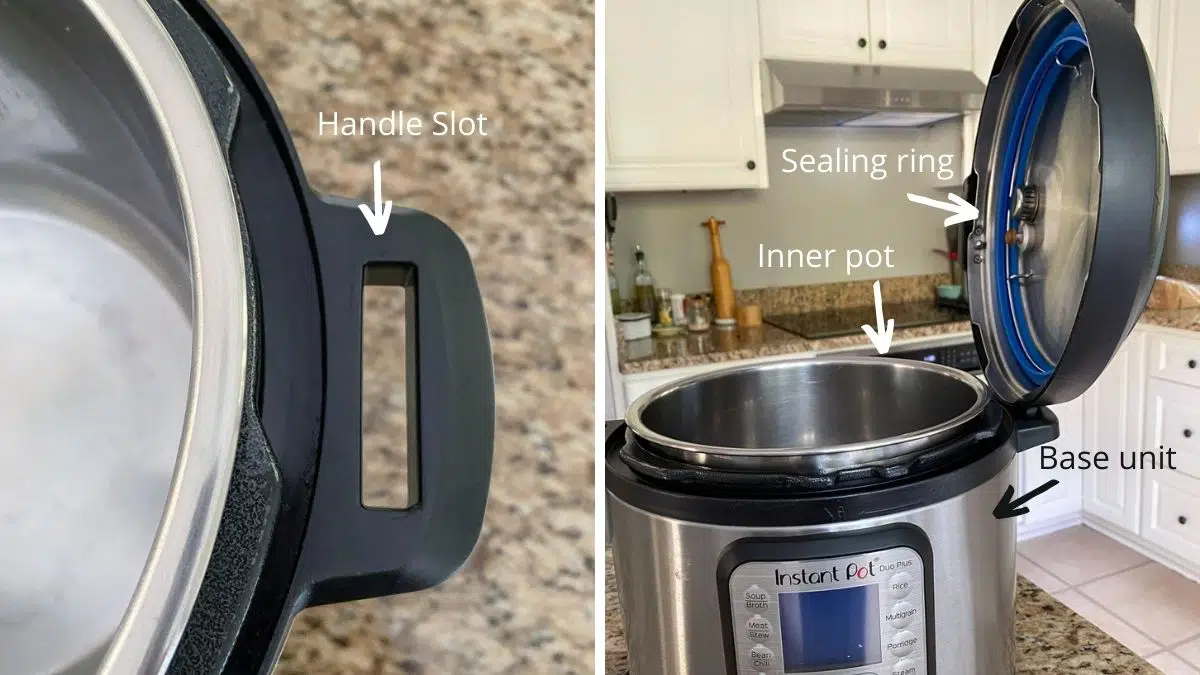
Condensation collector pictured below.
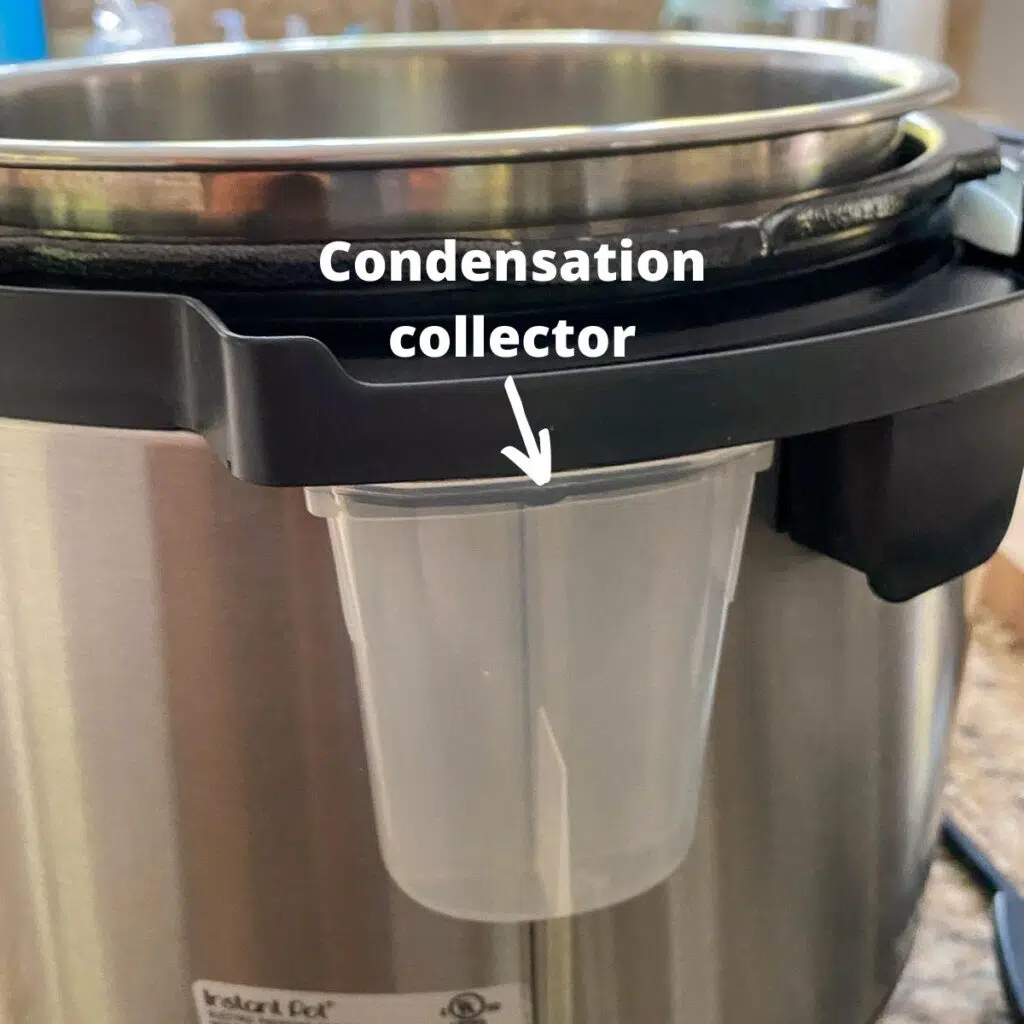
Lid: The lid of every Instant Pot comes fitted with a float valve (D – shown in the dropped position); a steam release knob (E), which when shutting the lid, needs to be in the sealed position (up); and a sealing ring. When the lid is placed onto the cooker and twisted to the locked position, the sealing ring helps create an airtight chamber. As the unit heats, the pressure inside the chamber builds, cooking your food.
When the Instant Pot comes to pressure, the float valve will rise up until its top is level with the surrounding lid. This alerts you that the IP is at pressure and will begin cooking.
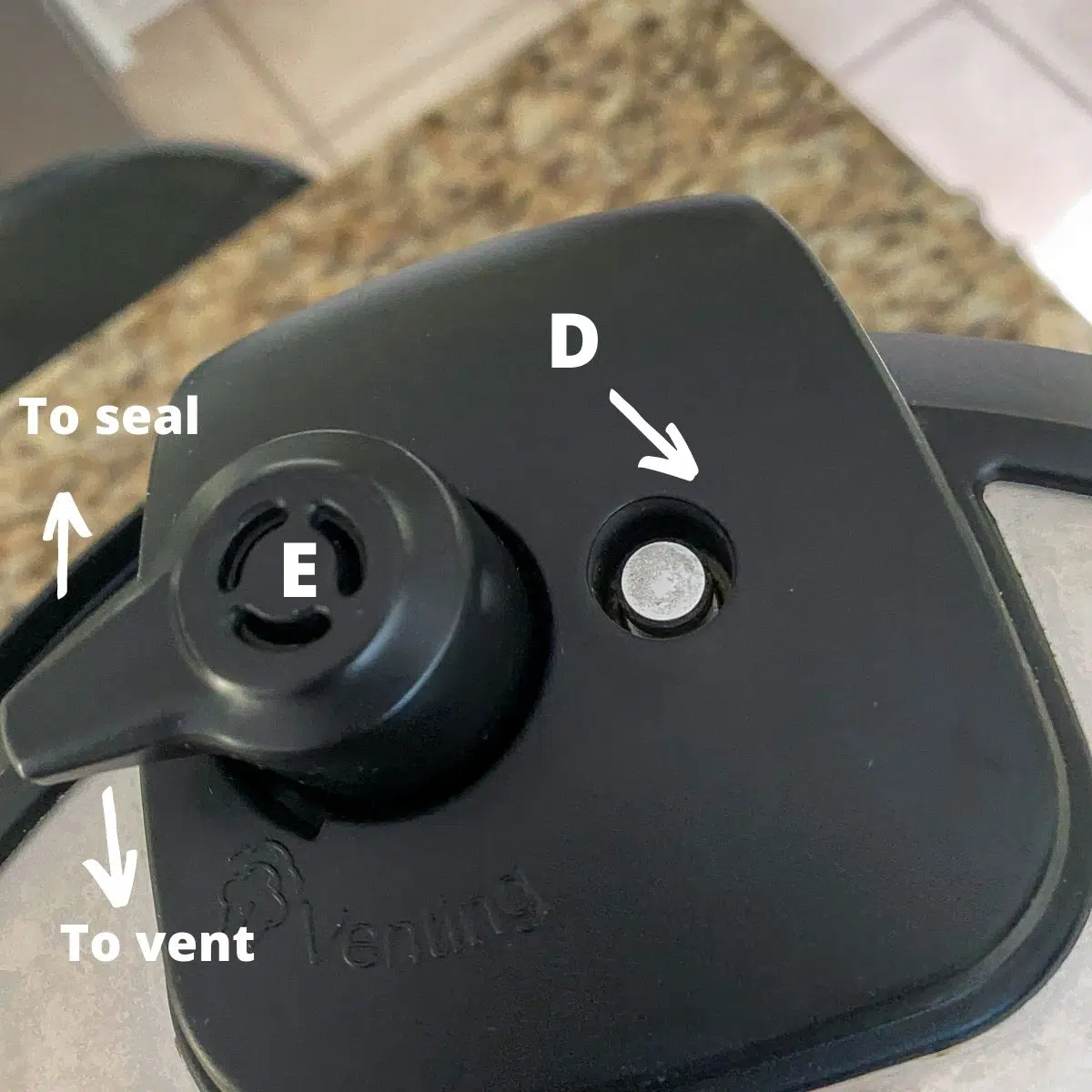
Natural or quick release
Steam Release Valve: Arguably the most important part of the Instant Pot, this is how you can control the pressure that is released from the device. You can choose to either 1) naturally release pressure by keeping the venting knob in place and waiting until the floating valve drops on its own or 2) do a quick release by turning the venting knob.
When the food is done and the Instant Pot beeps, say you decide to do a natural release. In this case, you don’t touch the venting knob and, depending on how full the pressure cooker is, you wait 15 to 25 minutes for the floating valve to drop. When the floating valve has dropped, you know the pressure has released and it is safe to open the lid.
If you’re in a hurry and prefer to do a quick release, you need to wait at least 5 minutes after the IP beeps (to tell you it’s done) before moving the venting knob. First you need to protect your hand from being burned by the steam that will be released. Don an oven mitt and carefully turn the venting knob towards the center of the lid. Above, you can see the notch below the knob and which way it should turn toward the word “Venting” next to a steam icon.
Wait several seconds to a minute for the steam to escape the lid and the floating valve to drop before opening the lid. There is a safety measure that prevents you from opening the lid when the pressure valve indicates the IP contents are still under high pressure.
Trivet: This is a stainless steel rack used to keep certain foods like meats and eggs from being submerged in your cooking liquid.
It’s important to keep in mind that the way an Instant Pot pressurizes is by using liquid, so whether you’re slow cooking or pressure cooking—always, always add water or some other liquid to your inner pot.
Ways to use an Instant Pot
So, what exactly can this thing do? Here are six ways, at least, your Instant Pot will serve you.
- Slow cook: Your brand new instant pot can actually replace your old slow cooker or crock pot. The slow cooker function has a set of temperatures ranging from low to high. To slow cook, load your ingredients into the inner pot and press the “slow cook” button. From there, adjust your cooking time anywhere from 30 minutes to several hours.
- Pressure cook: Pressure cooking is a great way to quickly cook lots of different foods (everything from rice and beans to meats). The pressure cooker function allows you to toss your ingredients into the pot, add some liquid, and let the Instant Pot do its thing. The Instant Pot is perfectly safe to walk away from, leaving you with plenty of time to relax or get work done.
- Cook rice: Imagine an appliance that could perfectly cook your rice, every time, in half the time. Well, now you’ve got it. Just select the “rice” function and let the magic happen.
- Sauté: This feature functions similarly to a frying pan or a flat-top grill. So, for recipes that require browning meat or sautéing veggies before cooking, this feature allows you to do so from the very same pot! It also allows you to thicken sauces and stews after cooking them.
- Cook yogurt: Ever wanted to make homemade yogurt? Well, now you can! All you have to do is add the milk of your choice to your pot, along with any additional flavors you want, and select the “yogurt” function.
- Steam: This function is perfect for steaming vegetables, fish, tofu, and any other food that you prefer to steam cook.
What to cook in an Instant Pot
One of the beautiful things about an Instant Pot is how versatile it is. By this I mean you can use it to cook meats, vegetables, rice, soups, yogurt, hard-boiled eggs, mashed potatoes, oatmeal, popcorn, pasta, applesauce—anything, really. Below are some of my favorite types of foods to cook in an Instant Pot.
- Meats: Instant Pots are perfect for cooking chicken, beef, pork, or other meats. All you have to do is line the bottom of your Instant Pot with the raw meat (even frozen meat will work!), in an even layer, add some liquid, and select the “pressure” function.
- Hard-boiled eggs: To hard boil some eggs, all you have to do is seal them inside your Instant pot alongside a cup or so of water. Select the “pressure” feature and follow the “5-5-5” method — 5 minutes to heat up, 5 minutes to cook, 5 minutes for the pressure to release before removing eggs.
- Soups/Stews: You can make any soup or stew you want in an Instant Pot. Simply sauté your veggies and/or brown your meat, then add in all of your spices and liquids. Once you’ve got your ingredients ready, you can choose to either slow cook or pressure cook your soup or stew to perfection.
Instant Pot hack
Above in the soup/stew section, I say that you can sauté your veggies or brown your meat. Mostly, I still brown my meat before I start cooking in the Instant Pot, but I’ve stopped sautéing vegetables.
Here’s why: I found that if I just place the vegetables in the pot with the rest of the ingredients, they taste no different than they do when I sauté them first. I save time and calories by not sautéing before sealing the pressure cooker and starting my timer.
Try it both ways and see which works best for you.
Instant Pot recipes for beginners
Instant Pots are the perfect one-stop shop for everyday use. Whether you want to make a pot of soup, cook some meat, make yogurt, or steam a batch of rice, this pot can get the job done. So, now that you’ve learned all that you need to know, here are a few of my favorite Instant Pot recipes to get you started on your cooking journey:
- Instant Pot Chicken Cacciatore
- Instant Pot Meatballs
- Instant Pot Black Bean Soup
- Instant Pot Butternut Squash Stew
- Instant Pot Spaghetti Sauce
- Instant Pot Potato Leek Soup
I hope you enjoyed this guide and found it helpful on how to use an Instant Pot. It was fun to write and share my love of this appliance with readers.
From lighting up stages with her BA in theater to food journalist, Elaine Benoit's journey is a testament to passion's transformative power. As the CEO of Dishes Delish, she offers a blend of healthy, comforting recipes and exquisitely crafted cocktails. Beyond the kitchen, Elaine voiced her culinary adventures on her podcast, "Dishing," and co-owns Food Blogger Help, extending her expertise to guide budding food bloggers to success. Whether it's for a heartwarming dish or insights into food blogging, Elaine's diverse experiences make her a beacon in the culinary digital landscape.

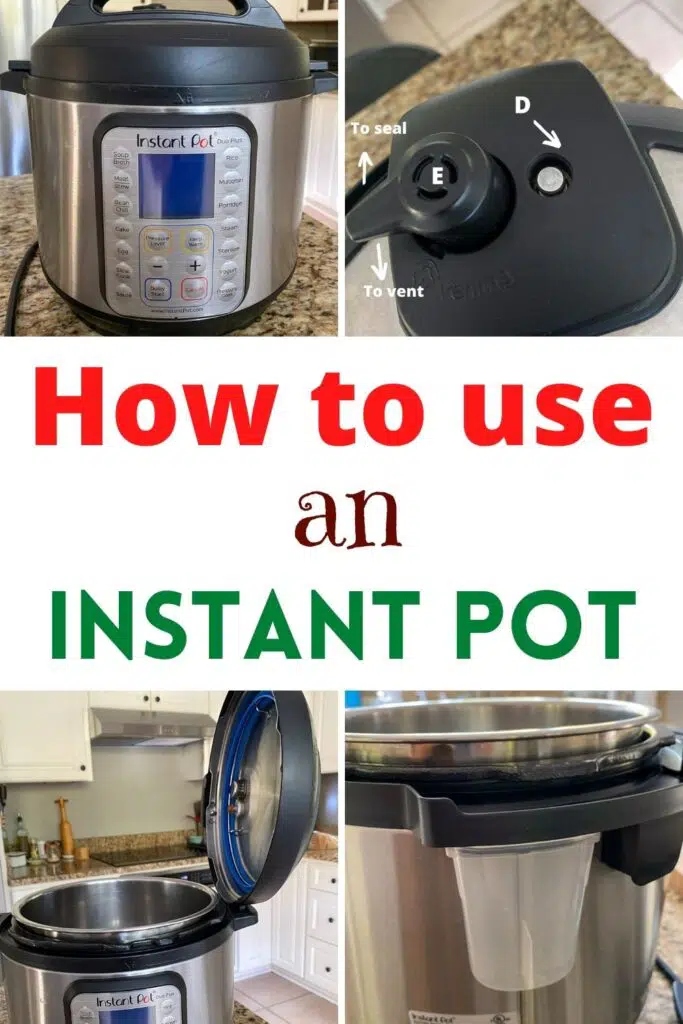

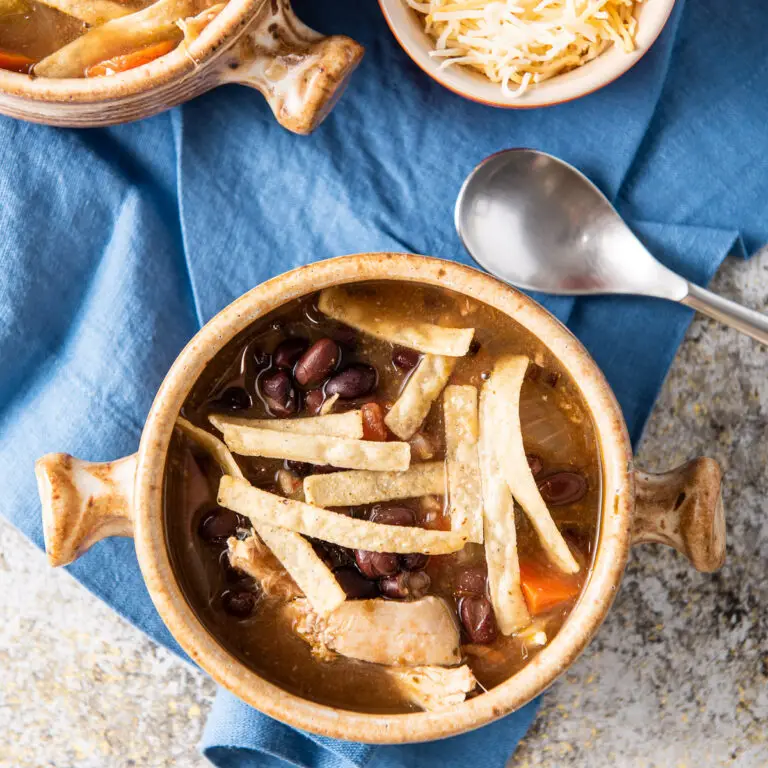

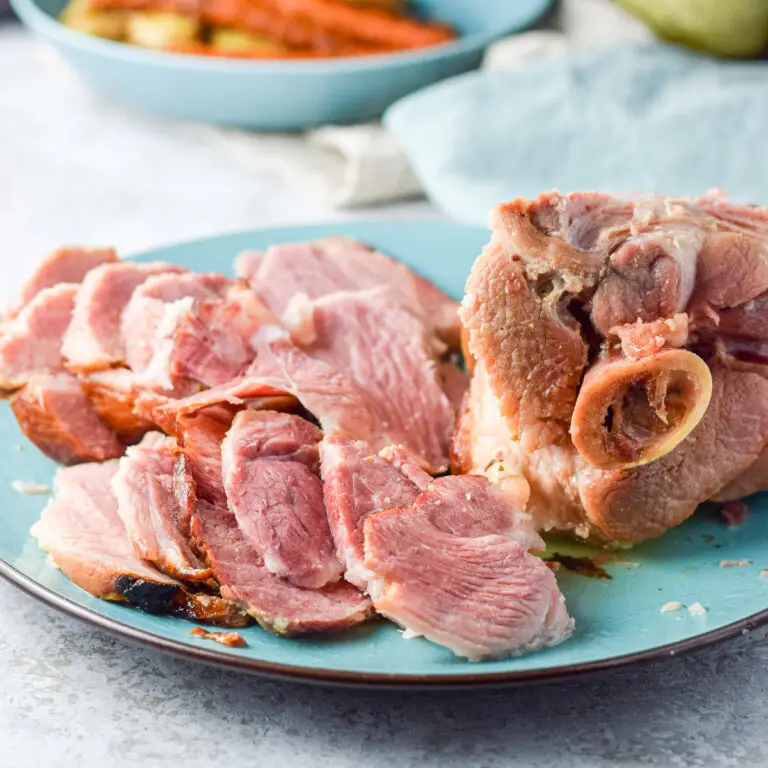
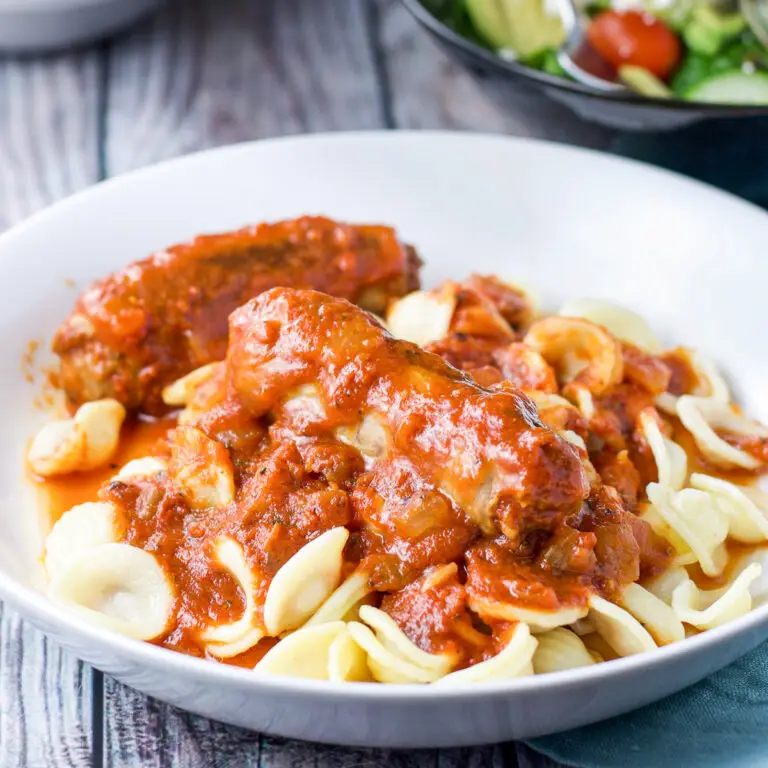

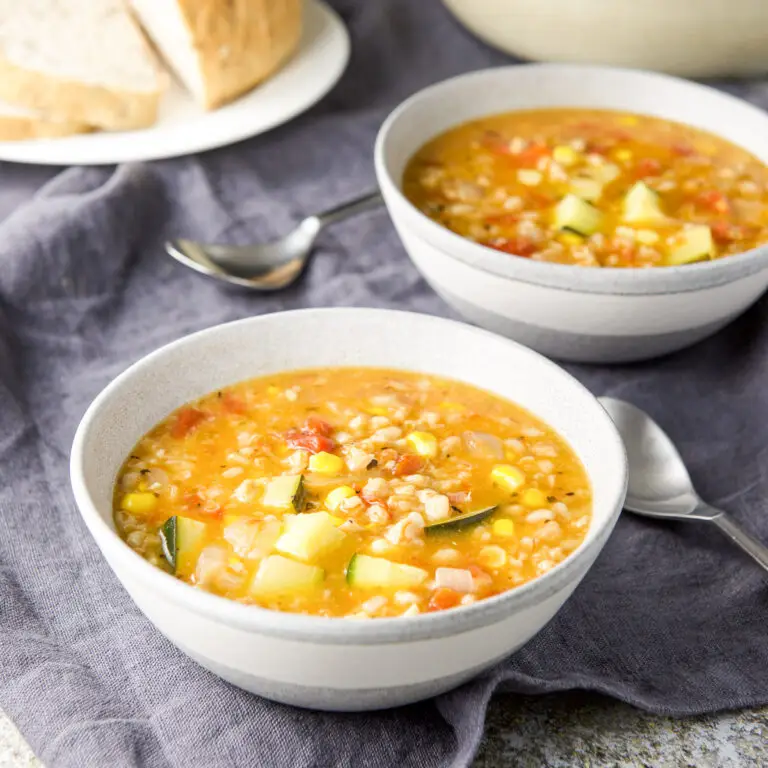
I love using my Instant Pot, this is a great guide for beginners. Thanks for sharing.
Me too Sharon. Thanks so much for commenting.
So many great tips! I needed this when I first got my IP, I was clueless!
Thanks so much, Gina! I appreciate it and I’m glad you found it helpful!
This is really helpful! Such a great guide! Thank you!
You’re welcome, Toni! I glad you found it helpful!
There are so many great tips in this post. We love out instant pot – it saves us so much time.
It really does. Thanks so much Dannii.